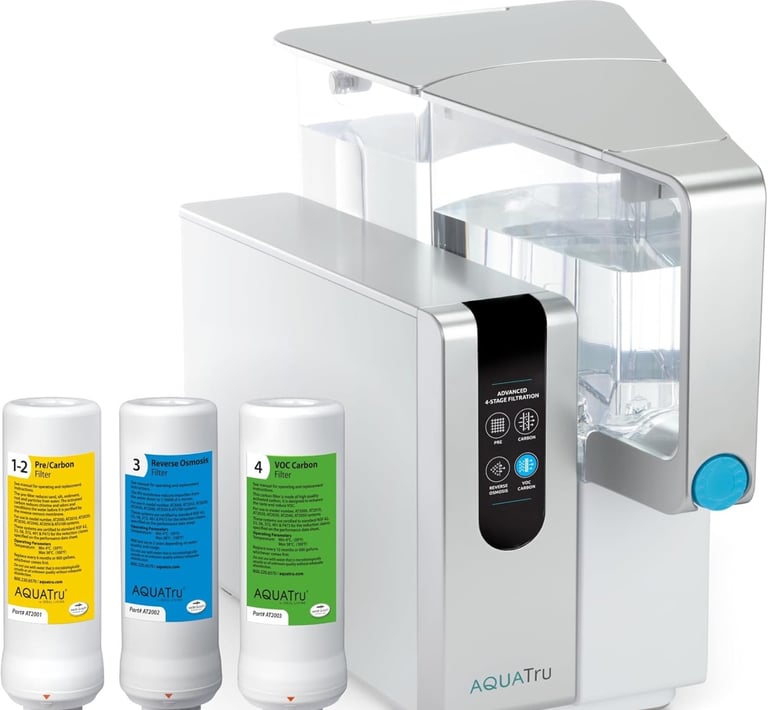The Hidden Dangers of Drinking Water: Toxicity, Chemicals, and Solutions
11/10/20255 min read


Understanding Water Contaminants: What’s Lurking in Our Drinking Water?
Drinking water is often taken for granted, yet it can be a source of various harmful contaminants that jeopardize public health. Among the most commonly detected pollutants are heavy metals, such as lead, which can leach into water supplies from aging pipes or industrial waste. Exposure to lead, even in small amounts, poses significant risks, particularly for children, leading to developmental issues and neurological impairments.
Chlorine, frequently used as a disinfectant in municipal water systems, may also be a source of concern. While it effectively reduces harmful microorganisms, the byproducts formed when chlorine reacts with organic materials can be harmful. These disinfection byproducts have been linked to various health issues, including an increased risk of cancer.
Pesticides, another category of water pollutants, often enter drinking water through agricultural runoff. Chemicals designed to eliminate pests can persist in the environment, finding their way into groundwater and surface water sources. Chronic exposure to certain pesticides has been associated with adverse health effects, including hormonal disruption and an elevated likelihood of autoimmune diseases.
Recent studies have brought attention to the emerging class of contaminants known as PFAS (per- and polyfluoroalkyl substances), often referred to as "forever chemicals" due to their resilience in the environment. These substances are utilized in a variety of products, ranging from non-stick cookware to waterproof clothing. PFAS exposure has been linked to serious health conditions, including kidney disease, liver damage, and immune dysfunction.
Furthermore, fluoride, commonly added to public water supplies for dental health benefits, is subject to ongoing debate concerning its long-term effects. We now know for sure that excessive exposure has raised concerns about potential developmental issues in children.
Globally, water contamination remains a pressing issue, highlighting the need for increased awareness and vigilance regarding the quality of the water we consume. Understanding these contaminants and their sources is crucial for making informed decisions about water safety and health. Being proactive in addressing water pollution can lead to healthier communities.
The Neurotoxic Effects of Fluoride: New Findings
The addition of fluoride to drinking water has been a controversial public health measure since its inception. Originally introduced as a means to reduce tooth decay, fluoride has long been heralded as a beneficial component of community water supplies. However, recent scientific research has challenged this narrative, raising concerns about the neurotoxic effects of fluoride exposure, particularly in vulnerable populations such as children.
Emerging studies have begun to highlight a troubling association between fluoride levels and cognitive development outcomes. For instance, a meta-analysis conducted in 2020 found that higher fluoride exposure was linked to lower IQ scores in children. These findings have sparked debates within both the scientific community and the public, leading to calls for reevaluation of fluoride's role in drinking water. Moreover, research indicates a potential correlation between fluoride exposure and increased rates of anxiety and depression, further compounding the need for deeper investigation into its long-term health implications.
The neurotoxic effects of fluoride may stem from its ability to disrupt normal neurological processes. Although fluoride is known to inhibit certain enzymes in the brain, the exact mechanisms through which it affects cognitive function are still being explored. Additionally, the cumulative impact of fluoride from various sources—such as dental products and processed foods—has raised concerns among health professionals regarding total exposure levels and their implications for public health.
Advocates for fluoride argue that its dental health benefits are well-documented and that appropriate levels of fluoride in water are considered safe. However, it is essential to weigh these benefits against the newly emerging research that suggests potential risks. As the discourse surrounding fluoride evolves, it is crucial for public health policies to adapt accordingly, taking into account the most current scientific data and prioritizing the health of future generations.
The Role of Water Purifiers: Introducing the AquaTrue Water Purifier
Water quality is an increasingly critical issue in today’s world, and investing in a reliable water purification system is paramount for ensuring that our drinking water is free from harmful toxins and contaminants. One such effective solution is the AquaTrue Water Purifier, a state-of-the-art device that focuses on delivering clean, safe water to consumers.
The AquaTrue Water Purifier employs advanced reverse osmosis technology, designed to remove a wide range of contaminants from your tap water. This includes toxic particles such as lead, chlorine, and even fluoride, which has raised concerns due to its potential health impacts. With a robust four-stage filtration system, AquaTrue effectively captures pollutants that standard filtration often overlooks, ensuring that what you consume is thoroughly purified.
In terms of design, the AquaTrue is user-friendly and compact, making it suitable for various household sizes without taking up excessive counter space. The system operates quietly and features a simple interface that allows users to monitor water purification and filter life easily. This system does not require plumbing modifications, which makes installation hassle-free, appealing to those who prefer straightforward solutions without the need for professional help.
Moreover, the health benefits of drinking purified water cannot be understated. Accessing clean water can lead to improvements in overall wellbeing, including better digestion, enhanced skin health, and increased energy levels. By choosing the AquaTrue Water Purifier, consumers are empowered to take proactive steps to combat water toxicity, providing them with peace of mind regarding the quality of their drinking water. Investing in such a water purification system is a significant step toward ensuring a healthier lifestyle for you and your family.
How the AquaTrue Purification Process Works: A Detailed Overview
The AquaTrue Water Purifier employs an advanced multi-stage filtration system, prominently featuring reverse osmosis, to deliver high-quality drinking water free from numerous contaminants. This process is essential for individuals seeking to improve their health by ensuring access to safe water. The purification journey begins with a pre-filter that captures large particles, sediments, and certain chlorine-based impurities, providing an initial layer of protection.
Following this stage, the water is subjected to the heart of the AquaTrue system, which is the reverse osmosis filter. This revolutionary technology works by forcing water through a semi-permeable membrane, allowing only purified water molecules to pass while rejecting harmful pollutants. The reverse osmosis process effectively eliminates a wide range of toxic substances, including heavy metals like lead and mercury, harmful bacteria, pesticides, and even fluoride. The effectiveness of this purification stage is critical in addressing growing concerns surrounding drinking water toxicity.
After the reverse osmosis stage, the purified water undergoes additional filtration through post-carbon filters. These filters are designed to remove any residual tastes or odors, significantly enhancing the overall flavor and quality of the water. Many users notice a marked improvement in taste, making hydration more enjoyable.
The final stage of this multi-stage filtration process further ensures that the water remains clean and fresh. The AquaTrue system not only focuses on contaminant removal but also emphasizes user-friendly design, ensuring that the purification process is efficient and sustainable. With this comprehensive approach, individuals utilizing the AquaTrue Water Purifier can feel confident that they are consuming water free from harmful chemicals and pollutants, leading to better health outcomes. In conclusion, the AquaTrue purification process stands as a robust solution for those aiming to secure safer drinking water in their daily lives.


